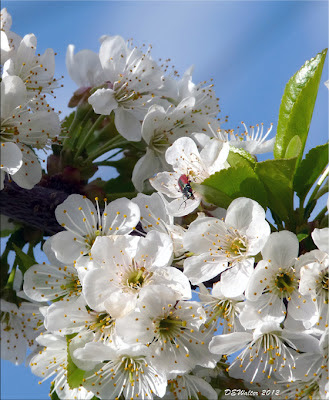 |
| Small male spider, possibly a Dwarf Spider |
A happy coincidence of chores done and some sun and warmth between squalls on Friday convinced Mrs Home Bug Gardener to leave the computer behind to continue her photographic documentation of the Home Bug Garden. As noted previously, the most notable activity was the buzzing around the spring bulbs. But here and there lurked a spider or two. The tiny wandering male above, I think it may be an erigonine linyphiid, proved a challenge - at 3-4 mm long, a tough shot - but also a surprise. Spiders aren't to everyone's taste, but something found this tiny spider tasty.
 |
| Ectoparasitoid - probably a wasp grub |
Spiders as a group get by almost entirely by feasting on insects. A few sip nectar at extrafloral nectaries, and possibly in flowers, and some sieve pollen out of the air with their webs. But by and large, spiders eat bugs. So, I guess it is only fair that a host of insects turn the tables on spiders and feast on them. Generally, spiders are eaten from the inside out by their parasitoids*, or at least their egg masses are, but beetles and mantids munch them up and hunting wasps pack them into cells as a feast for their grubs. There are also a few that get by with a more precarious existence - perched on the outside of the spider as in this picture. This seems to be the grub of an Ichneumonidae in what is called the '
Polysphincta Genus Group' . I assume this means the group is a taxonomic mess, but at
BugGuide Bob Carlson has contributed a very nice series of pictures showing the life cycle of one such wasp.
 |
| Docile Digger Wasp |
On the whole, I think I'd rather sip nectar like a bee, than suck on spider insides, but that is a personal choice and I know many people find the larger spiders
tasty (NB - the poor quality of the video provides some protection, but if you are afraid of spiders, do not watch this video). But another surprise of the afternoon was finding something that likes to eat bees in my own backyard.
 |
| Tritrophic interaction: flower, bee, and ? |
This particular Digger Bee (
Andrena cf
milwaukeensis) was extremely accommodating as a photographer's model. And if you look closely at the posterior of the abdomen you will see the probable reason.
 |
| Stylops female - the protruding blob |
Alas, this particular bee is more than she seems. Most of her insides are a new ordinal record for the Home Bug Garden - a Twisted-wing Insect: Strepsiptera. I think this is a species of
Stylops, parasites of
Andrena bees, and while I am delighted to find the 349th species of insect so far identified in the HBG, I do feel a bit sorry for the bee. This type of parasitism is called 'stylopization' and as many as a quarter of the Digger Bees in an area may be parasitized**. The males of
Stylops have to be seen to be believed. As yet, we have no pictures, but Nico's Wild bees & wasps photo stream has a
spectacular picture of a male attempting copulation.
References
*Oliver-D. Finch. 2005. The parasitoid complex and parasitoid-induced mortality
of spiders (Araneae) in a Central European woodland. Journal of Natural History 39(25): 2339–2354.
http://www.terreco.uni-oldenburg.de/Medien/Download/TNAH_39_25_06.pdf
**Davy & Grace Jones. 1981. Stylopization of Andrena spp. (Hymenoptera: Andrenidae) by Stylops crawfordi (Strepsiptera: Stylopidae) in Texas. Journal of the Kansas Entomological Society
54(2): 223-227.


































